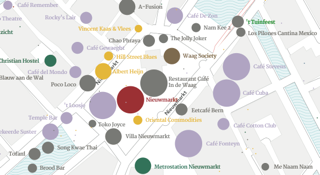Capturing Urban Memory with Sentient Data, Counter Mapping and Digital Methods
Abstract
This paper puts forward a conceptual proposition that ties the discourses on ‘urban memory’ (Stillman and Johanson, 2009; Ringas, Christopoulou, Stefanidakis., 2011; Loughran, Fine & Hunter, 2015), sensory ethnography (Pink 2017 ), and counter-mapping (Crampton and Krygier 2018; ) with digital methods (Rogers, Sánchez-Querubín, and Kil, 2015).
As an ‘interventionist’ approach, we understand co-producing counter (dynamic) maps with local stakeholders (actors), coupled with sensory and sentient data as a way of capturing the memory of urban peripheral landscapes (through intervention and participation) and thus creating archival knowledge.
Urban memory is often understood as a form of collective memory that isconstituted by individual experiences within the place itself and through its historyand social environment (Ringas et al., 2011).
With rapid changes in digitaltechnologies, digital and material have become “inseparate and entangled inenvironments people move and navigate their lives through'' (Pink and Fors, 2017).M emories are “evoked with material engagement with devices” which “opens up afield of sensory and affective engagement” research (ibid). While Pink and Forspropose to follow such engagement in a mundane and everyday setting, seen as anon-representational, phenomenological approach, we put forward a mixedmethods approach that connects sensory and sentient data (as agents) with the largerenvironmental context.
Urban areas are often conceptualized as sites of ‘creative destruction’, in between stability and change, space (that can be developed) and place (that is lived in), often subjected to planning, regulation, and economic forces (Batty, 2007). This is especially true for urban areas that are located outside of the ‘center’ or in the cities’ periphery. These areas have experienced an endless cycle of deconstruction and reconstruction often witnessed and captured by local inhabitants, creatives, and activists.
Currently, many of the peripheral areas are emancipating, bringing forward and openly communicating their complexities, values, and engaging various stakeholders in their regeneration efforts (which happens in a broader context of many European cities repositioning themselves in more polycentric and polyphonic ways, (Scott, 2015).
To be able to capture the memory of ever-changing, ‘built a new’ urban places, we put forward counter (dynamic) mapping using digital methods as complemented with sensory and sentient data generated through interactions with digital technologies. Building on Crampton’s notion of maps (Crampton and Krygier, 2018), cartography is understood as existence (becoming) rather than essence (fixed ontology).
Maps are therefore taken not as ‘objects’, but as performative practices. Digital methods, on the other hand, enable us to understand dynamic place-making, through ‘tracing’ the stakeholders (actors) and their relations overtime to capture the ways the urban environment gets performed.
To clarify with an example, in Spinoza Imaginaries Lab & Cafe situated inAmsterdam Southeast we have been capturing the ever changing urbanenvironment in partnership with local stakeholders (actors), mapping their evolvingrelationships (and grouping) using the IssueCrawler and sentient data co-gatheredby researchers and students, with the clear understanding that to be able to capturea place, it is important to map the vernacular knowledge of that place (imaginaries,including art, movies, unrealized plans and initiatives, etc.). We propose this mixedmethods approach as an epistemological practice geared towards archiving thedynamic state of urban peripheral landscapes.